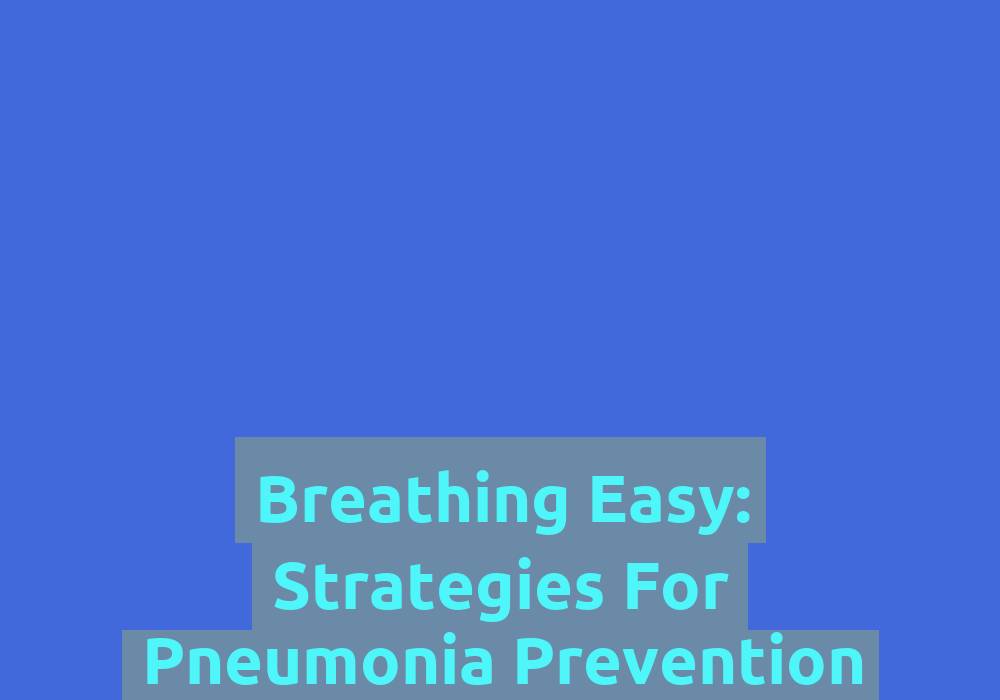Why the Conjugate Vaccine is Crucial in Pneumococcal Prevention

In recent years, the importance of vaccination in preventing infectious diseases has become increasingly evident. One such vaccine that has proven to be crucial in the prevention of pneumococcal infections is the conjugate vaccine. This innovative vaccine has revolutionized the approach to combating pneumococcal diseases, significantly reducing the morbidity and mortality associated with these infections. In this article, we will delve into the reasons why the conjugate vaccine is essential in pneumococcal prevention.
What is Pneumococcal Disease?
Pneumococcal disease refers to a range of infections caused by the bacterium Streptococcus pneumoniae, commonly known as pneumococcus. These infections can manifest as pneumonia, meningitis, otitis media (middle ear infection), sinusitis, and other invasive diseases. Pneumococcal disease can affect people of all ages, but infants, young children, the elderly, and individuals with weakened immune systems are at a higher risk of severe complications and mortality.
Importance of Understanding Pneumococcal Disease
It is crucial to understand the impact and severity of pneumococcal disease to appreciate the significance of the conjugate vaccine in its prevention. Pneumococcal infections can lead to severe complications, including pneumonia and meningitis, which can be life-threatening, especially in vulnerable populations. By understanding the potential consequences of pneumococcal disease, we can better appreciate the importance of prevention through vaccination.
The Global Burden of Pneumococcal Disease
Pneumococcal disease poses a significant global health concern, causing millions of cases and hundreds of thousands of deaths each year. The burden of pneumococcal infections is particularly high in developing countries with limited access to healthcare resources. By implementing effective prevention strategies, such as vaccination with the conjugate vaccine, we can reduce the global burden of pneumococcal disease and save countless lives.
Risk Factors for Pneumococcal Infections
Certain populations, such as infants, young children, the elderly, and individuals with weakened immune systems, are at a higher risk of developing severe pneumococcal infections. Understanding these risk factors is crucial in identifying the target populations for vaccination and implementing effective prevention measures. By targeting these high-risk groups, we can maximize the impact of the conjugate vaccine in preventing pneumococcal diseases.
The Need for Pneumococcal Prevention
Pneumococcal infections are a significant global health concern, causing millions of cases and hundreds of thousands of deaths each year. The bacterium can spread from person to person through respiratory droplets, making it highly contagious. Moreover, pneumococcal disease is responsible for a substantial burden on healthcare systems, leading to hospitalizations, antibiotic use, and long-term sequelae.
Impact of Pneumococcal Infections on Healthcare Systems
The burden of pneumococcal infections on healthcare systems cannot be overstated. These infections often require hospitalization, intensive care, and prolonged antibiotic treatments. By preventing pneumococcal infections through vaccination, we can alleviate the strain on healthcare systems, reduce hospitalizations, and minimize the use of antibiotics. This, in turn, allows healthcare resources to be allocated more effectively to other critical areas.
Long-Term Consequences of Pneumococcal Infections
Pneumococcal infections can have long-term consequences, even for individuals who survive the acute phase of the illness. Complications such as hearing loss, cognitive impairment, and chronic respiratory problems can significantly impact the quality of life of affected individuals. By preventing pneumococcal infections through vaccination, we can reduce the occurrence of these long-term sequelae and improve the overall well-being of individuals and communities.
Impact on Vulnerable Populations
Certain populations, such as infants, young children, the elderly, and individuals with weakened immune systems, are more susceptible to severe pneumococcal infections. These individuals often face higher mortality rates and more significant complications. By prioritizing vaccination with the conjugate vaccine in these vulnerable populations, we can protect those who are most at risk and ensure their well-being.
Introduction to the Conjugate Vaccine
The conjugate vaccine is a type of vaccine that combines a piece of the pneumococcal bacterium with a carrier protein. This innovative approach enhances the immune response to the vaccine and provides protection against pneumococcal infections. The conjugate vaccine is typically administered in multiple doses, ensuring a robust and long-lasting immune response.
Mechanism of Action of the Conjugate Vaccine
The conjugate vaccine works by stimulating the immune system to recognize and attack the pneumococcal bacterium. By combining a piece of the bacterium with a carrier protein, the vaccine enhances the immune response and trains the body to recognize and eliminate the pathogen. This targeted approach ensures that the immune system is prepared to defend against pneumococcal infections.
Importance of Multiple Doses
Administering the conjugate vaccine in multiple doses is crucial to ensure optimal protection against pneumococcal infections. Multiple doses help to boost and maintain the immune response over time, providing long-lasting immunity. It is essential to adhere to the recommended vaccination schedule to maximize the effectiveness of the conjugate vaccine and achieve the desired level of protection.
Safety and Side Effects
Like any vaccine, the conjugate vaccine has undergone extensive testing to ensure its safety and efficacy. The most common side effects are typically mild and include pain or redness at the injection site, low-grade fever, and mild fatigue. Severe adverse reactions are rare. It is important to consult with healthcare professionals to address any concerns and make informed decisions regarding vaccination.
Effectiveness of the Conjugate Vaccine
The conjugate vaccine has been extensively studied and proven to be highly effective in preventing pneumococcal diseases. Clinical trials have demonstrated its effectiveness in reducing the incidence of invasive pneumococcal disease, pneumonia, and other related infections. Moreover, the vaccine has shown efficacy in preventing pneumococcal colonization, which plays a significant role in the transmission and spread of the bacterium.
Clinical Evidence of Effectiveness
Numerous clinical studies have unequivocally demonstrated the effectiveness of the conjugate vaccine in preventing pneumococcal diseases. These studies have shown significant reductions in the incidence of invasive pneumococcal disease and pneumonia in vaccinated populations compared to unvaccinated populations. The overwhelming evidence supports the use of the conjugate vaccine as a crucial tool in pneumococcal prevention.
Impact on Disease Burden
The widespread use of the conjugate vaccine has led to a significant reduction in the burden of pneumococcal diseases. By preventing infections and reducing their severity, the vaccine has saved countless lives and improved the overall health of communities. The impact of the conjugate vaccine on disease burden highlights its importance as a public health intervention.
Long-Term Protection
One of the key advantages of the conjugate vaccine is its ability to provide long-term protection against pneumococcal infections. The robust immune response generated by the vaccine ensures that individuals remain protected for an extended period. This long-lasting protection is essential in preventing recurrent infections and reducing the overall burden of pneumococcal diseases.
Benefits of the Conjugate Vaccine
1. Protection against Multiple Strains
Pneumococcus is a highly diverse bacterium, with more than 90 known serotypes. The conjugate vaccine provides protection against the most common serotypes responsible for pneumococcal diseases. By targeting multiple strains, the vaccine significantly reduces the risk of infection and its associated complications.
2. Herd Immunity
One of the significant benefits of widespread vaccination with the conjugate vaccine is the concept of herd immunity. When a significant portion of the population is vaccinated, it creates a barrier against the spread of the bacterium. This indirectly protects individuals who may not be eligible for vaccination, such as infants too young to receive the vaccine or individuals with compromised immune systems.
3. Reduction in Antibiotic Resistance
Pneumococcal infections have become increasingly challenging to treat due to the emergence of antibiotic-resistant strains. By preventing the infections in the first place, the conjugate vaccine can contribute to a reduction in antibiotic use and the development of resistance. This helps preserve the effectiveness of antibiotics for other bacterial infections.
4. Cost-Effectiveness
Investing in pneumococcal prevention through vaccination has proven to be cost-effective in the long run. Vaccination programs reduce healthcare costs associated with hospitalizations, antibiotic treatments, and sequelae of pneumococcal diseases. Additionally, preventing these infections improves productivity by reducing the number of sick days taken by individuals affected by pneumococcal diseases.
Vaccine Recommendations and Schedule
The administration of the conjugate vaccine follows specific recommendations and schedules based on age groups and risk factors. It is vital to consult with healthcare professionals and adhere to the vaccination schedule to ensure optimal protection against pneumococcal diseases.
Age-Specific Recommendations
The conjugate vaccine is recommended for infants and young children, as they are particularly susceptible to severe pneumococcal infections. The vaccination schedule typically includes several doses administered at specific intervals. It is important to follow the recommended schedule to ensure that children receive the full benefit of the vaccine and develop long-lasting immunity.
High-Risk Groups
In addition to infants and young children, certain high-risk groups, such as the elderly and individuals with specific medical conditions, may require additional doses or a modified vaccination schedule. Healthcare professionals can provide guidance on the appropriate vaccination recommendations for these individuals to ensure optimal protection against pneumococcal diseases.
Conclusion
The conjugate vaccine has emerged as a crucial tool in the prevention of pneumococcal diseases. Its effectiveness, ability to protect against multiple strains, and contribution to herd immunity make it an essential intervention in public health. By embracing vaccination with the conjugate vaccine, we can significantly reduce the burden of pneumococcal infections, save lives, and improve the overall well-being of communities worldwide.
1. What is pneumococcal disease?
Pneumococcal disease refers to a range of infections caused by the bacterium Streptococcus pneumoniae, including pneumonia, meningitis, otitis media, sinusitis, and other invasive diseases.
2. Why is the conjugate vaccine important in preventing pneumococcal infections?
The conjugate vaccine is crucial in preventing pneumococcal infections because it has been proven to significantly reduce the morbidity and mortality associated with these infections.
3. What are the risk factors for pneumococcal infections?
Certain populations, such as infants, young children, the elderly, and individuals with weakened immune systems, are at a higher risk of developing severe pneumococcal infections.
4. What are the benefits of the conjugate vaccine?
The benefits of the conjugate vaccine include protection against multiple strains of pneumococcus, herd immunity, reduction in antibiotic resistance, and cost-effectiveness in the long run.


















